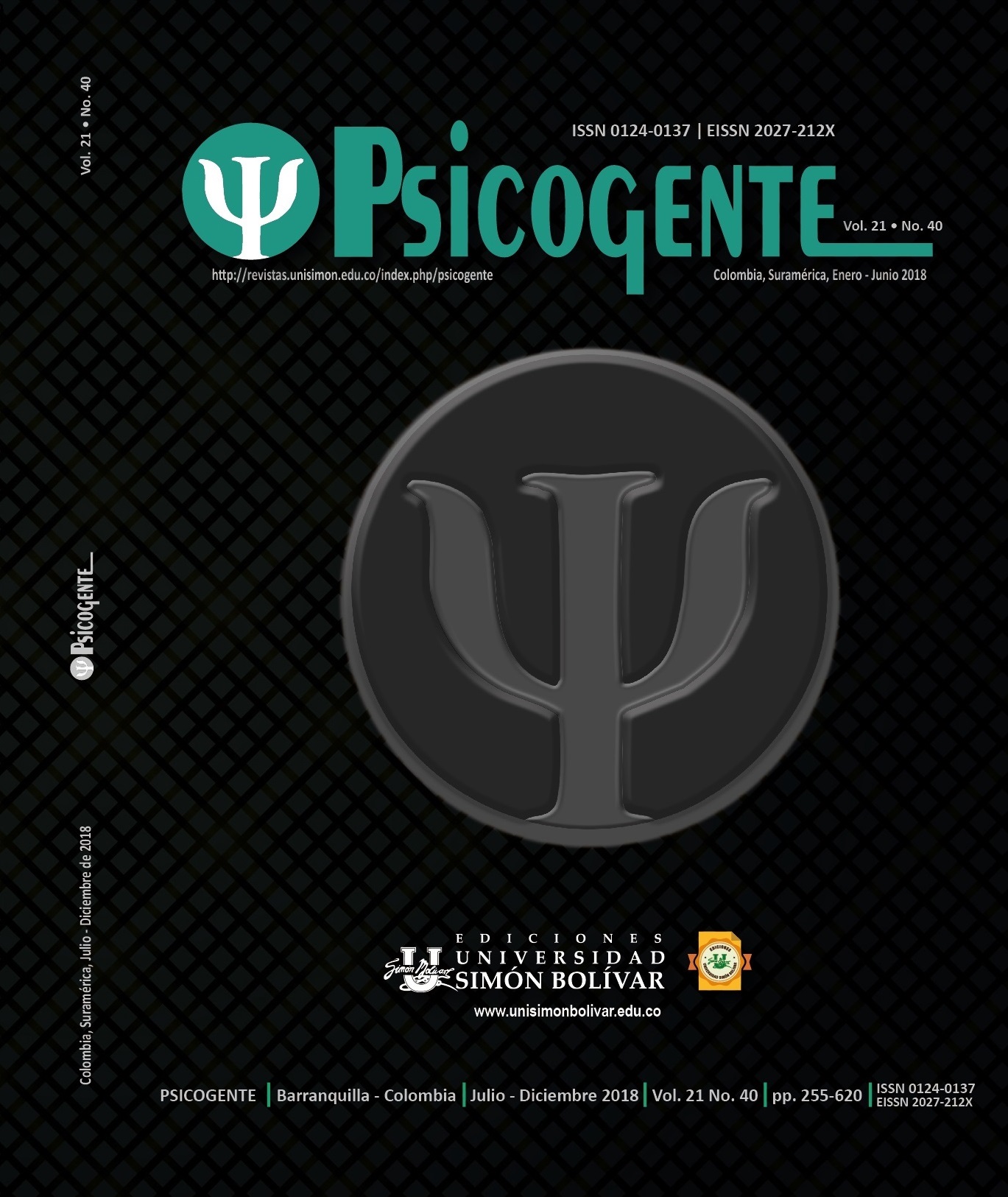Análisis de correlación entre la audición y la flexibilidad cognitiva en una población adulta mayor de Sincelejo, Colombia
Correlation analysis between hearing and cognitive flexibility in the older adult population of Sincelejo, Colombia
DOI:
https://doi.org/10.17081/psico.25.47.4911Palabras clave:
función auditiva, función ejecutiva, presbiacusia, envejecimientoResumen
Introducción: La presente investigación estudió el sistema auditivo y las habilidades ejecutivas, específicamente la flexibilidad cognitiva, en población longeva y buscó aportar a la evidencia científica existente, el impacto que pueden tener ambas en la calidad de vida de la población adulta mayor.
objetivo: Se determinó la relación entre la función auditiva y la flexibilidad cognitiva de una población adulta mayor del municipio de Sincelejo, Colombia.
Método: Se realizó un estudio cuantitativo, no experimental, correlacional, transversal, a una población de 140 adultos mayores. Para la selección de la muestra se aplicó un muestreo intencional por criterios de inclusión (pertenecientes a la institución, que firmarán el consentimiento informado) y de exclusión (déficit cognitivo, diabetes, enfermedades neurológicas diagnosticadas, alteraciones visuales o auditivas, sobrepasar la edad del test), la muestra quedó conformada por 49 adultos mayores. Se empleó como instrumentos de recolección de la información para la audición, pruebas audiológicas de audiometría tonal y logoaudiometría; y para la medición de la función ejecutiva, Test de clasificación de tarjetas de Wisconsin.
Resultados: Se demostraron diferencias entre la variable respuesta de nivel conceptual del test entre los grupos de edad (p: 0,037), pérdidas auditivas de alta frecuencia entre leve y moderado (25-40DbBHL; 40-60DBHL), buen nivel de discriminación del habla, y una asociación estadística entre sensibilidad auditiva y número total de errores (0,336, 0,357 p=0,05); la sensibilidad auditiva y las respuestas perseverativas y errores perseverativos (0,343, 0,301 p=0,05), discriminación del habla, respuesta a nivel conceptual (-0,375; -0,397 p=0.0) y fallos para mantener actitud (0,441; 0,456 p=0,01).
Conclusión: Cuanto mayor deterioro en el procesamiento periférico y central auditivo exista, mayor es la tendencia perseverativa, la dificultad para abstracción y formación de conceptos, así como el cambio de estrategias de un adulto mayor en tareas que impliquen funcionamiento ejecutivo.
Descargas
Citas
Acosta, M. (2000). Síndrome del hemisferio derecho en niños: correlación funcional y madurativa de los trastornos del aprendizaje no verbales. Revista de Neurología, 31(4), 360-367. https://www.neurologia.com/articulo/2000268
Anguera, J. A., Boccanfuso, J., Rintoul, J. L., Al-Hashimi, O., Faraji, F., Janowich, J., Kong, E., Larraburo, Y., Rolle, C., Johnston, E., & Gazzaley, A. (2013). Video game training enhances cognitive control in older adults. Nature, 501(7465), 97-101. https://www.nature.com/articles/nature12486
Angulo, E. (1997). Audioprótesis, teoría y práctica. España: Masson, S.A. Aragón-Torres, J. A., Forische, P. W., Hernández, K. M., y Rodríguez-Valero, M. (2019). Hipoacusia y deterioro cognitivo en adultos mayores. Anales Médicos de la Asociación Médica del Centro Médico ABC, 64(4), 265-269.
Ardila, A., Bernal, B., & Rosselli, M. (2016). How localized are language brain areas? A review of Brodmann areas involvement in oral language. Archives of Clinical Neuropsychology, 31(1), 112-122. https://doi.10.1093/arclin/acv08 1
Axelrod, B.N., y Henry, R. R. (1992). Rendimiento relacionado con la edad en la clasificación de tarjetas de Wisconsin, similitudes y pruebas controladas de asociación de palabras orales. The Clinical Neuropsychologist, 6(1), 16-26. https://doi.org/10.1080/13854049208404113
Bock, O., Haeger, M., & Voelcker-Rehage, C. (2019). Structure of executive functions in young and in older persons. PLoS One, 14(5), e0216149.
Cantú, D., Lera, J., y Baca, J. (2017). Especialización hemisférica y estudios sobre lateralidad. Revista de Psicología y Ciencias del Comportamiento de la Unidad Académica de Ciencias Jurídicas y Sociales, 8(2), 6-50. : https://doi.org/10.29365/rpcc.20171229-58
Chi, Y. K., Han, J. W., Jeong, H., Park, J. Y., Kim, T. H., Lee, J. J., Lee, S. B., Park, J. H., Yoon, J. C., Kim, J. L., Ryu, S-H., Jhoo, J. H., Lee, D. Y., & Kim, K. W. (2014). Development of a screening algorithm for Alzheimer’s disease using categorical verbal fluency. PloS one, 9(1), e84111. https://doi.org/10.1371/journal.pone.0084111
Cohen, R. A., Marsiske, M. M., y Smith, G. E. (2019). Neuropsicología del envejecimiento. En Manual de neurología clínica. Elsevier.
Collette, F., Germain, S., Hogge, M., & Van der Linden, M. (2009). Inhibitory control of memory in normal ageing: Dissociation between impaired intentional and preserved unintentional processes. Memory, 17(1), 104-122. https://doi.org/10.1080/09658210802574146
Cruickshanks, K. J., Zhan, W., & Zhong, W. (2010). Epidemiology of age-related hearing impairment. The aging auditory system, 33, 259-274. DOI: https://doi.org/10.1007/978-1-4419-0993-0_9
De Zubicaray, G. I., Smith, G. A., Chalk, J. B., & Semple, J. (1998). The Modified Card Sorting Test: Test‐retest stability and relationships with demographic variables in a healthy older adult sample. British Journal of Clinical Psychology, 37(4), 457-466. https://doi.org/10.1111/j.2044-8260.1998.tb01403
Deal, J. A., Betz, J., Yaffe, K., Harris, T., Purchase-Helzner, E., Satterfield, S., ... & Health ABC Study Group. (2017). Hearing impairment and incident dementia and cognitive decline in older adults: the health ABC study. Journals of Gerontology Series A: Biomedical Sciences and Medical Sciences, 72(5), 703-709.
Diamond, A., & Ling, D. S. (2019). Aerobic-Exercise and resistance-training interventions have been among the least effective ways to improve executive functions of any method tried thus far.
Diamond, A., y Ling, D. S. (2016). Conclusiones sobre intervenciones, programas y enfoques para mejorar las funciones ejecutivas que parecen estar justificadas y las que, a pesar de la exageración, no lo están. Neurociencia Cognitiva del Desarrollo, 18, 34-48. https://doi.org/10.1016/j.dcn.2015.11.005
Dinsdale, N. L., Reddon, A. R., & Hurd, P. L. (2011). Sex differences in the relationship between aggressiveness and the strength of handedness in humans. Laterality: Asymmetries of Body, Brain and Cognition, 16(4), 385-400. https://doi.org/10.1080/13576501003683087
Eckert, M. A., Cute, S. L., Vaden, K. I., Kuchinsky, S. E., & Dubno, J. R. (2012). Auditory cortex signs of age related hearing loss. Journal of the Association for Research in Otolaryngology, 13(5), 703-713. https://doi.org/10.1007/s10162-012-0332-5
Feder, K. P., Michaud, D., Ramage-Morin, P., McNamee, J., & Beauregard, Y. (2015). Prevalence of hearing loss among Canadians aged 20 to 79: Audiometric results from the 2012/2013 Canadian Health Measures Survey. Health Report 26(7), 18-25. https://pubmed.ncbi.nlm.nih.gov/26177043/
Fernández, E., y González, Y., (2018) Sistema de acciones para la estimulación de flexibilidad cognitiva y control inhibitorio en la gimnasia rítmicaescolar: OLIMPIA. Revista de la Facultad de Cultura Física de la Universidad de Granma, 16(54), 44-57. https://dialnet.unirioja.es/servlet/articulo?codigo=7000693
Gates, G. A., Gibbons, L. E., McCusrry, S. M., Crane, P. K., Feeney, M. P., & Larson, E. B. (2010). Executive dysfunction and presbycusis in older people with and without memory loss and dementia. Cognitive and Behavioral Neurology, 23(4), 218-223. https://doi.org/10.1097/WNN.0b013e3181d748d7
Gómez, O. (2012). Audiología básica. Universidad Nacional de Colombia. Grimm, A., Friedland, K., & Eckert, A. (2016). Mitochondrial dysfunction: the missing link between aging and sporadic Alzheimer’s disease. Biogerontology, 17(2), 281-296. https://doi.org/10.1007/s10522-015-9618-4
Gutiérrez, A. L., y Solís, F. O. (2011). Desarrollo de las Funciones Ejecutivas y de la Corteza Prefrontal. Revista Neuropsicología, Neuropsiquiatría y Neurociencias, 11(1), 159-172. https://dialnet.unirioja.es/servlet/articulo?codigo=3640871
Hardy, C. J., Marshall, C. R., Golden, H. L., Clark, C. N., Mummery, C. J., Griffiths, T. D., ... & Warren, J. D. (2016). Hearing and dementia. Journal of neurology, 263(11), 2339-2354.
Heaton, R., Chelune, G., Talley, J., Kay, G. y Curtiss, G. (2009). Test de Clasificación de tarjetas de Wisconsin. Madrid: TEA ediciones.
Hernández Sampieri, R., Fernández Collado, C., y Baptista Lucio, P. (2014). Metodología de la investigación. McGraw-Hill Education.
Hinkle, D. E., Wiersma, W., & Jurs, S. G. (2003). Applied statistics for the behavioral sciences (Vol. 663). Houghton Mifflin College Division.
Howard, M., & Reggia, J. (2010). The effects of multi-task learning and time-varying hemispheric asymmetry on lateralisation in a neural network model. Laterality: Asymmetries of Body, Brain and Cognition, 9(2), 113-131. https://doi.org/10.1080/13576500244000300
Ihle, A., Oris, M., Baeriswyl, M., Zuber, S., Cullati, S., Maurer, J., & Kliegel, M. (2019). The longitudinal relation between social reserve and smaller subsequent decline in executive functioning in old age is mediated via cognitive reserve. International Psychogeriatrics, 1-7. https://doi.org/10.1017/S1041610219001789
Introzzi, I., Canet-Juric, L., Montes, S., López, S., & Mascarello, G. (2015). Inhibitory processes and cognitive flexibility: evidence for the theory of attentional inertia. International Journal of Psychological Research, 8(2), 60-74. https://doi.org/10.21500/20112084.1510
Ivern, I., Valero, J., Signo, S., Vila, J. M., Català, M., & Talleda, N. (2017). Relación entre audición y cognición durante el envejecimiento: la escucha dicótica como instrumento de evaluación.
Karr, J. E., Areshenkoff, C. N., Rast, P., Hofer, S. M., Iverson, G. L., & Garcia-Barrera, M. A. (2018). The unity and diversity of executive functions: A systematic review and re-analysis of latent variable studies. Psychological Bulletin, 144(11), 1147-1185. https://doi.org/10.1037/bul0000160.
Katz, J., Chasin, M., Hood, L. J., y Tillery, K. L. (1978). Manual de audiología clínica (Vol. 428). Williams y Wilkins.
Lalwani, A. (2008). Diagnóstico y tratamiento en otorrinolaringología. Cirugía de cabeza y cuello. Editorial Lange.
Lange, F., Kröger, B., Steinke, A., Seer, C., Dengler, R., & Kopp, B. (2016). Decomposing card-sorting performance: Effects of working memory load and age-related changes. Neuropsychology, 30(5), 579. https://doi.org/10.1037/neu0000271
Lawson, G. D., & Peterson, M. E. (2011). Speech audiometry. Plural Publishing. Miranda, A. R., Franchetto Sierra, J., Martínez Roulet, A., Rivadero, L., Serra, S. V., &
Soria, E. A. (2019). Age, education and gender effects on Wisconsin card sorting test: standardization, reliability and validity in healthy Argentinian adults. Aging, Neuropsychology, and Cognition, 26(6)1-19. https://doi.org/10.1080/13825585.2019.1693491
Miyake, A., Friedman, N. P., Emerson, M. J., Witzki, A. H., Howerter, A., & Wager, T. D. (2000). The unity and diversity of executive functions and their contributions to complex “frontal lobe” tasks: A latent variable analysis. Cognitive psychology, 41(1), 49-100. https://doi.org/10.1006/cogp.1999.0734
Monsell, S. (2003). Task switching. Trends in cognitive sciences, 7(3), 134-140. https://doi.org/10.1016/S1364-6613(03)00028-7
Muñoz-Céspedes, J. M., y Tirapu-Ustárroz, J. (2004). Rehabilitación de las funciones ejecutivas. Revista de Neurología, 38(7), 656-663. https://www.redalyc.org/pdf/4235/423539527005.pdf
Organización Mundial de la Salud –OMS–. (2021). Envejecimeinto y salud. Ginebra,- Suiza.Centro de prensa, notas descriptivas.Recuperado el 12 de marzo de 2022 de: https://www.who.int/es/news-room/fact-sheets/detail/ageing-andhealth#:~:text=Desde%20un%20punto%20de%20vista,y%20finalmen
Panza, F., Solfrizzi, V., & Logroscino, G. (2015). Age-related hearing impairment—a risk factor and frailty marker for dementia and AD. Nature Reviews Neurology, 11(3), 166. https://doi.org/10.3389/fnagi.2015.00113
Peelle, J. E. (2018). Listening effort: How the cognitive consequences of acoustic challenge are reflected in brain and behavior. Ear and hearing, 39(2), 204.
Peelle, J. E., Troiani, V., Grossman, M., & Wingfield, A. (2011). Hearing loss in older adults affects neural systems supporting speech comprehension. Journal of neuroscience, 31(35). https://doi.org/12638-12643
Peña, O. H. (2019). Prevalencia del síndrome demencial con alteraciones auditivas. Revista Cubana de Otorrinolaringología y Cirugía de Cabeza y Cuello, 3(2).
Pinto, A., Reyes, V., Weis, M., y Barra, B. (2019). Hipoacusia como factor de riesgo de un trastorno neurocognitivo: Una revisión de la literatura. Psiquiatría y Salud mental, 36(3), 138-42.
Pletnikova, A., Reed, N. S., Amjad, H., Yasar, S., Nowrangi, M., Betz, J., ... & Oh, E. S. (2019). Identification of hearing loss in individuals with cognitive impairment using portable tablet audiometer. Perspectives of the ASHA Special Interest Groups, 4(5), 947-953. https://doi.org/10.1044/2019_PERS-SIG8-2018-0018
Rammal, S., Abi Chahine, J., Rammal, M., Fares, Y., & Abou Abbas, L. (2019). Modified Wisconsin Card Sorting Test (M-WCST): Normative data for the lebanese adult population. Developmental Neuropsychology, 44(5), 397-408. https://doi.org/10.1080/87565641.2019.1652828
Romanucci, M., & Della Salda, L. (2015). Oxidative stress and protein quality control systems in the aged canine brain as a model for human neurodegenerative disorders. Oxidative medicine and cellular longevity, 2015, 1-9. https://doi.org/10.1155/2015/940131
Romine, C. B., Lee, D., Wolfe, M. E., Homack, S., George, C., & Riccio, C. A. (2004). Wisconsin Card Sorting Test with children: a meta-analytic study of sensitivity and specificity. Archives of Clinical Neuropsychology, 19(8), 1027-1041. https://doi.org/10.1016/j.acn.2003.12.009
Romo Galindo, D. A., Ortiz Jiménez, X. A., Minerva Aída, G. G., y Ramírez Tule, M. C. (2015). Análisis de la inhibición y flexibilidad cognoscitiva en el adulto mayor. Ciencia UANL, 18(76), 56-61. http://cienciauanl.uanl.mx/wp-content/uploads/2016/01/art.-COCOCIMIENTO.pdf
Sama, D. M., & Norris, C. M. (2013). Calcium dysregulation and neuroinflammation: discrete and integrated mechanisms for age-related synaptic dysfunction. Ageing research reviews, 12(4), 982-995. https://doi.org/10.1016/j.arr.2013.05.008
Selkoe, D. J., & Hardy, J. (2016). The amyloid hypothesis of Alzheimer’s disease at 25 years. EMBO molecular medicine, 8(6), 595-608.
Sogebi, O. A., Olusoga-Peters, O. O., & Oluwapelumi, O. (2013). Clinical and audiometric features of presbycusis in Nigerians. African health sciences, 13(4), 886-892. http://dx.doi.org/10.4314/ahs.v13i4.4
Stach, B. A. (1998). Clinical Audiology. An Introduction. DELMAR CENGAGE Learning. Suárez, C., Gil-Carcedo, L., Marco, J., Medina, JE., Ortega, P y Trinidad, J. (2015). Tratado de otorrinolaringolia y cirugia de cabeza y cuello. Buenos Aires: Editorial Medica Panamericana.
Walteros, D. P., y Neira, L. I. (2010). Validez y confiabilidad del listado de monosílabos colombianos. Revista Colombiana de Rehabilitación, 9(1), 16. https://revistas.ibero.edu.co/index.php/arete/article/view/418
Whitley, E., Deary, I. J., Ritchie, S. J., Batty, G. D., Kumari, M., & Benzeval, M. (2016). Variations in cognitive abilities across the life course: Cross-sectional evidence from Understanding Society: The UK Household Longitudinal Study. Intelligence, 59, 39-50. https://doi.org/10.1016/j.intell.2016.07.001
Publicado
Cómo citar
Número
Sección
Licencia
Derechos de autor 2022 Karina Sofía Lastre Meza, María Emma Guardo Marchán, Yoselín Gutiérrez Meza

Esta obra está bajo una licencia internacional Creative Commons Atribución 4.0.
Desde la revista Psicogente impartimos una política de respeto con nuestra comunidad científica incluyendo a nuestros autores. Los autores tienen derecho a un trato respetuoso y atento en el proceso Editorial, que las evaluaciones de sus artículos sean justas, imparciales (para ello la revista procederá con la evaluación doble ciego) y se realicen en un tiempo razonable. Se deberá mantener la confidencialidad y los permisos para proceder con la publicación. Todo cambio solicitado por parte del comité, los pares y el Editor deberán ser explícitos y claramente justificados. Especifica que los autores/as conservarán sus derechos de autor y garantizarán a la revista el derecho de primera publicación de su obra, el cual estará simultáneamente sujeto a la Licencia de reconocimiento de Creative Commons BY que permite a terceros compartir la obra siempre que se indique su autor y su primera publicación a esta revista.
Garantizamos un proceso editorial transparente: desde las acciones de recepción del articulo hasta la validación final del mismo, se hará en comunicación constante con el autor. Las modificaciones en el estado de los artículos, así como las diversas decisiones tomadas sobre él y los tiempos de ejecución empleados se realizarán haciendo uso de la plataforma OJS y de ser necesario en contacto directo a través del correo de autores y de la revista Psicogente. Así mismo se procura la escogencia de Pares revisores idóneos: con perfiles y experiencia que lleven a una avaluación de calidad de cada documento sometido a revisión.






